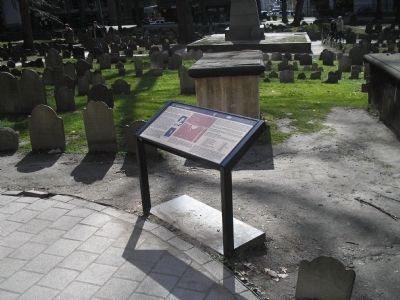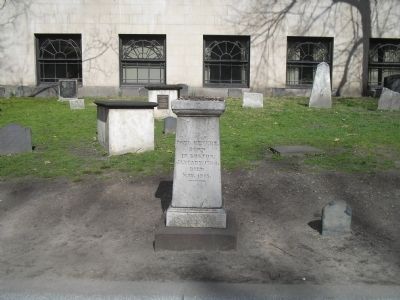Downtown in Boston in Suffolk County, Massachusetts — The American Northeast (New England)
Colonial Craftsmen
Nathaniel Hurd (1730-1777) and Benjamin Hurd (1739-1781) were engravers, silversmiths, and goldsmiths. Nathaniel designed the seal of Harvard College and, like Paul Revere, he was painted by John Singleton Copley in his working clothes.
Paul Revere (1734-1818) was also a master engraver, silversmith, and goldsmith who lived in Boston’s North End. But he is most famous as one of the patriots who made the “midnight ride” to warn John Hancock and Sam Adams of the British march to Concord on April 18, 1775. Revere was an active “Son of Liberty,” helped plan the Boston Tea Party, and participated in the Revolutionary War. Later he became an industrialist, whose copper foundry and rolling mill made brass fittings for the U. S. S. Constitution and the Massachusetts State House’s original dome. He and his second wife, Rachel (Walker) (1745-1813), are buried in tomb 127. His first wife, Sarah (Orne) Revere, and his father, Paul Revere, are buried near Sign #3.
Samuel Gore (1751-1831) was a painter, japanner, and printer, who participated in the Boston Tea Party. He and his brother Governor Christopher Gore (1758-1829), are buried in the Gore family tomb (123). Other Boston Tea Party participants buried in this section of Granary are retailer Henry Bass (1739-1842), Tomb 178; hatter Joseph Eaton (1750-1825), Tomb 200; Joseph Lee (1744-1831), Tomb 125; and William Pierce (1744-1840), Tomb 173.
John Hull (1624-1683), silversmith, goldsmith, and the colony’s mint master and treasurer, was one of the leading craftsmen of Boston in the 17th century. With his partner, Robert Sanderson (d. 1693), he produced the “pine-tree” shilling and other colonial coinage. He also created silver and gold tableware for his customers.
John Hull’s only daughter, Hannah (1658-1717), married Judge Samuel Sewall (1652-1730) and bore him 14 children. Only seven children survived to adulthood and all are buried here. Seawall is probably best known as one of the judges at the Salem Witchcraft trials. In 1696 he publicly asked forgiveness for his condemnation of those innocent people. In 1700 he published The Selling of Joseph, an anti-slavery treatise. Upwards of 40 Hull-Quincy-Sewall family members were buried in Tomb 185 over two centuries.
Also buried nearby is Abiah Holbrook (1718-1769), master of the South Writing School on West Street from 1742-1769. He taught John Hancock his penmanship.
John Foster Williams (1743-1814) was a patriot privateer and naval officer who fought many battles and was captured by the British in 1781. He was the captain of the revenue cutter Massachusetts for 24 years.
African and African American Burials
In colonial Boston the free black community resided in Boston’s North End and most often chose Boston’s second burying ground, Copp’s Hill, for burial. The rates for burials in 1732 were as follows:
For white man or woman….. – 10 shillings
For persons 6 to 12 years of age….. – 7 shillings
For children caryed by hand….. – 6 shillings
For negro man or woman….. -7 shillings & 6 pence
Ditto from 6 to 12 years of age….. – 6 shillings
For children….. – 4 shillings
For opening the new or wall Toombes….. – 14 shillings
For opening an old Tomb….. – 16 shillings
Some Africans who lived in the area around Granary Burying Ground had been slaves and were buried in the tombs of their masters. Cloe Spear (d. 1815) was an African woman who was captured and sold into slavery at a young age. Although freed after the Revolution, she is buried in the tomb (199) of her owner, Capt.
John Bradford (d. 1784). Her autobiography entitled Memoir of Mrs. Chloe Spear, a Native of Africa, Who was Enslaved in Childhood, and Died in Boston, January 3, 1815, Aged 65 Years was published in Boston in 1832 and is a rare northern slave narrative.
Topics. This historical marker is listed in these topic lists: Colonial Era • Industry & Commerce • Settlements & Settlers • Waterways & Vessels. A significant historical date for this entry is January 3, 1903.
Location. Marker has been reported missing. It was located near 42° 21.453′ N, 71° 3.724′ W. Marker was in Boston, Massachusetts, in Suffolk County. It was in Downtown. Marker could be reached from Tremont Street, on the left when traveling north. Marker is along the walking trail in Granary Burying Ground, near the back of the cemetery. Touch for map. Marker was in this post office area: Boston MA 02108, United States of America. Touch for directions.
Other nearby markers. At least 8 other markers are within walking distance of this location. John Foster Williams (within shouting distance of this marker); Josiah and Abiah Franklin (within shouting distance of this marker); Boston Athenaeum (within shouting distance of this marker); Congregational House (within shouting distance of this marker); Chester Harding House (within shouting distance of this marker); Victims of the Boston Massacre (within shouting distance of this marker); Granary Burial Ground (within shouting distance of this marker); Paul Revere Buried in this Ground (within shouting distance of this marker). Touch for a list and map of all markers in Boston.
More about this marker. The center of the marker contains a partial map of Granary Burying Ground showing the location of the marker and nearby graves. Also on the marker is a John Singleton Copley painting of Nathaniel Hurd; and a photograph of a Paul Revere Tankard, courtesy of the Bostonian Society and Old State House.
Related markers. Click here for a list of markers that are related to this marker. Take a tour of the markers found along the walking trail in Boston’s Granary Burying Ground.
Also see . . . Granary Burying Ground. Details of the Freedom Trail from the City of Boston website. (Submitted on May 10, 2009, by Bill Coughlin of Woodland Park, New Jersey.)
Credits. This page was last revised on January 30, 2023. It was originally submitted on May 10, 2009, by Bill Coughlin of Woodland Park, New Jersey. This page has been viewed 2,077 times since then and 28 times this year. Photos: 1, 2, 3. submitted on May 10, 2009, by Bill Coughlin of Woodland Park, New Jersey.


